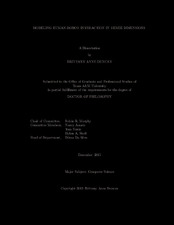| dc.description.abstract | This dissertation answers the question: Can a small autonomous UAV change a person's movements by emulating animal behaviors? Human-robot interaction
(HRI) has generally been limited to engagements with ground robots at human height or shorter, essentially working on the same two dimensional plane, but this ignores potential interactions where the robot may be above the human such as small un- manned aerial vehicles (sUAVs) for crowd control and evacuation or for underwater or space vehicles acting as assistants for divers or astronauts. The dissertation combines two approaches {behavioral robotics and HRI {to create a model of \Comfortable Distance" containing the information about human-human and human-ground robot interactions and extends it to three dimensions. Behavioral robotics guides the ex- amination and transfer of relevant behaviors from animals, most notably mammals, birds, and ying insects, into a computational model that can be programmed in simulation and on a sUAV. The validated model of proxemics in three dimensions makes a fundamental contribution to human-robot interaction. The results also have significant benefit to the public safety community, leading to more effective evacuation and crowd control, and possibly saving lives. Three findings from this experiment were important in regards to sUAVs for evacuation: i) expressions focusing on the person, rather than the area, are good for decreasing time (by 7.5 seconds, p <.0001) and preference (by 17.4 %, p <.0001), ii) personal defense behaviors are best for decreasing time of interaction (by about 4 seconds, p <.004), while site defense behaviors are best for increasing distance of interaction (by about .5 m, p <.003), and iii) Hediger's animal zones may be more applicable than Hall's human social zones when considering interactions with animal behaviors in sUAVs. | en |


